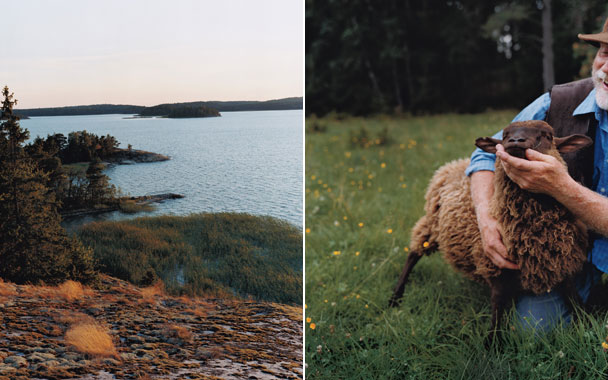Whenever I arrive at Steninge, my mother’s family estate on the southwest coast of Finland, the casual intimacy with nature always startles me at first.
“I heard the nightingale yesterday,” someone will remark, sitting on the lawn in front of my grandparents’ red wooden villa.
“Oh, is he back? I haven’t heard him yet,” someone else will say, glancing over the top of the newspaper.
Back home in my Brooklyn apartment, I deliberately try to keep most of the local wildlife out. My ears are more attuned to the sound of the self-appointed “concierge” of my building, Crazy Howard, throwing bottles at neighborhood teens than they are to warbling birdsong. My sister practically calls Interpol whenever she sees a mouse, and my brother couldn’t pick a bird out of a police lineup. But every summer since my American father and Finnish mother married, more than 30 years ago, and settled down in the States, they (and, eventually, we kids) have been returning to Steninge. It never takes long for Finnish cottage life to rewire our brains. Pretty soon, I’m joining the fray: “Was a chicken singing outside my window last night?”
“Yes, the pheasant was announcing his availability,” my moth-er informs me, as if the bird were extended family.
Steninge exists in complete privacy—a handful of aunts and uncles live in scattered forest cottages connected by footpaths to my grandparents’ villa. We can dart naked from sauna to sea, like blanched potatoes into an ice bath, in the bright evening light. We wear what we call the Finland Collection, beloved tatters from ink-spotted dress shirts to patched-up pants that have a second life at Steninge. We can dress like a lost tribe of boxcar children, and no one’s the wiser.
It wasn’t always like this.
My great-grandfather purchased the estate more than a century ago, having returned to his native Finland after 17 years as a watchmaker and goldsmith in Australia. Some 20 families lived on the farm. The men worked in the fields, growing rye, barley, and oats. The women worked in the manor house or in the 100-cow dairy. My grandfather sold the fields in the 1960s, and now the work that used to require teams of men is accomplished by two or three.
Steninge reflects a broader pattern: In 1950, 47 percent of Finns made their living through farming and forestry (the two have been linked since the 1890s, with forestry supplementing the income of Finland’s relatively small, family-owned farms). Today, the percentage of the population living off agriculture is in the single digits. But if the demographics seem to have shifted—the updated image of the Finn is the sleek, Nokia—toting city dweller—summer sets the clock back.
In a country of only about 5.2 million people, where forests still cover 69 percent of the land, a sizable portion of the population retreats to almost 500,000 summer cottages. Forty percent of the population fishes, and more than half engage in berry picking or mushroom foraging. These statistics come as no surprise to anyone who has traveled the southern countryside and seen everyone from toddlers to grandmothers waving their barbed fishing hooks overhead or, like detectives, combing the undergrowth with their brushes and knives.
Afternoons at one o’clock, the cottages at Steninge empty out and our family converges on the villa. My grandmother sets out the rye rolls and strong coffee that used to constitute a farmer’s field break. Coffee time, when we chat idly and pass around newspapers and cream, provides us with our daily dose of socializing. In a day that begins and ends with suitless dunks in the sea, it’s a good excuse to put on pants.
It’s also an excuse for baking. When my mother was growing up in the shadow of World War II and war reparations to the Soviet Union, only on Sunday might coffee time include a cake or pulla—the sweet, cardamom-flecked bread so beloved here that it should be etched onto the Finnish coat of arms, right between the lion’s jaws. Long after rationing ended, habits of parsimony and home industry have endured. My grandfather, a former judge in the Turku Court of Appeals, collected honey from his own beehives and made wine from his currants and tea from his mint. He still lays out nets for fish and tends to a vegetable garden and an orchard with my grandmother. As children, my mother and her sisters fried doughnuts outside in a kettle of oil in the summer months, and in the winter they molded caramel lollipops in wax-paper cones set in the snow. Nowadays, though, pies and cakes show up frequently at coffee time in the hands of my aunts and cousins, a response to the panic-inducing superabundance of wild blueberries, strawberries, and raspberries lining the roads along the property.
The cult of summer in Finland reaches a particular frenzy at Midsummer, the longest day of the year, which Finns celebrate with a fire marshal’s nightmare of beer and bonfires. My family gathers on a massive granite slab called Karinokka, which slopes into the sea at the end of the property. Much of the southwestern coastline looks like Karinokka: Ancient rock (some of the oldest bedrock in Europe) juts out from the forest in varying formations, from huge cliffs to jagged wedges.
At Midsummer, across the seascape we see the bonfires of our neighbors, with whom we have a vague feeling of competition. Fortunately, my uncle Juha is an engineer who specializes in combustion. My small coterie of relatives ends up standing a long way back, holding very long sticks, roasting hot dogs in what looks like the fallout of a flame-ravaged department store. Atop the rock, we watch the sun set slowly, crankily, over long hours of pinks and purples. It dips below the treetops, then comes right back up again.




 Pinterest
Pinterest






